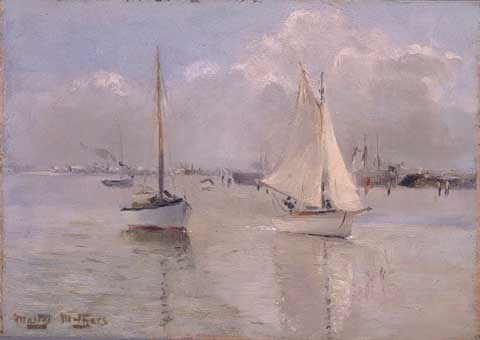The Artists
Walter Withers
WALTER WITHERS
YACHTS OFF WILLIAMSTOWN

WALTER WITHERS
Born England
1854, Arrived Australia 1883, Died 1914
YACHTS OFF WILLIAMSTOWN
oil on composition board
24.0 x 34.2 cm
Purchased with the assistance of a special grant
from the Government of Victoria, 1979
Collection: National Gallery of Victoria, Melbourne
Williamstown is a city and suburb in the inner south of metropolitan Melbourne. It is Melbourne's oldest suburb and first port. It is situated approximately eleven kilometres south west of the centre of Melbourne, and lies on the Gellibrand Peninsula.
The Gellibrand Peninsula forms the south western arm of Hobsons Bay, named after Captain William Hobson, Commander of 'H.M.S. Rattlesnake' who surveyed the bay.
Williamstown was first named The Anchorage, and then around 1836, Gellibrand's Harbour, after Joseph Tice Gellibrand. Point Gellibrand and the Gellibrand Peninsula were also named after Joseph Tice Gellibrand, although originally John Batman had named the point, Point Harwood, after the Master of the 'Rebecca'.
On 10 April 1837, Governor Sir Richard Bourke named the area William's Town in honour of King William IV. Governor Bourke personally thought that the site of William's Town was better than Melbourne for the capital of a new settlement, and called it after the reigning monarch. William IV in 1830 succeeded George IV, and was in turn succeeded by his niece, Victoria. On 8 October 1837, news reached Sydney of the death of King William IV, and the accession to the throne of Queen Victoria, who reigned from 1837 to 1901.
The local Aborigines referred to the William's Town locality as 'koort-boork-boork', a term meaning 'clump of she-oaks'.
In October 1838, the small steamer 'Fire Fly' began operating between William's Town and Port Melbourne, although the first jetty was not built at William's Town until 1839.
Australia's first telegraph line began operating between Melbourne and William's Town on 3 March 1854.
During the time of the gold rushes, between 1852 and 1857, because of the dramatic rise in crime and lack of space to hold criminals, the Government purchased deserted sailing ships, painted them bright yellow, and moored them off Point Gellibrand. Here the prisoners were held in these floating jails and many were taken ashore daily to work in gangs at the nearby basalt (bluestone) quarries. The bluestone was used for retaining walls, some of the early roads and in many of the early buildings.
Williamstown, as we now call this suburb, became a city in 1919. It has a wealth of history dating back to the 1830's, with an Historical Museum, heritage buildings, maritime relics, such as the 'H.M.A.S. Castlemaine', a restored World War II minesweeper moored at Gem Pier, and large wharves and ship building and repair yards. The Williamstown Lighthouse and Timeball Tower situated on Gellibrand Point have appeared in many an artwork, and these were built in 1852.
Over the years, many artists have been attracted to the beauty of Williamstown's vibrant waterside and have tried to capture the colourful spectacle of the many yachts in sail and the many ships at berth.
Walter Withers often visited Williamstown for a day's outing, and at times he would take with him members of his family. He would arrive by train from Melbourne, or by the Williamstown Ferry, which linked Williamstown to Melbourne, across Hobsons Bay and the entrance to the Yarra River.
Most of Walter Withers' works of Williamstown were painted around 1910, at a time when Frederick McCubbin was also painting the Williamstown landscape.
McCubbin, between 1909 and 1915, visited Williamstown on numerous occasions and produced sketches and watercolours of the foreshore and the old shipyards, and also produced a major oil painting of the Williamstown docks in 1915. McCubbin would also take members of his family with him on these outings and occasionally included them in his paintings.
Withers painted this work from the vicinity of Burgoyne Reserve, which was named after General Sir George Burgoyne. The site would have been close to where the Williamstown Sailing Club is situated today. Withers view is across the bay to the major piers, jetties and shipyards that are situated to the north of the far easterly point of Williamstown. Today yachts still sail in this area, although Williamstown is now a heavily industrialized port.
Other artists who painted in the vicinity of Williamstown, included J.H. Harcourt who produced a view towards Williamstown across Hobson's Bay in the 1860's, Reginald Ward Sturgess, who was known as the watercolourist of Williamstown, and later, John Perceval.
A more detailed entry on the life and works of Walter Withers can be located under the 'Artists of the Heidelberg School' on this Internet site.
Andrew Mackenzie
Copyright Notice
No works can be copied from this site. Permission to publish or reproduce
can be sought from the National
Gallery of
Victoria, Melbourne.
All Rights Reserved medialaunch Pty. Ltd.
Collection: National Gallery of Australia, Canberra.
ABN 69 067 524 921
Tel: +61 3 98185700 Fax: +61 3 98185044
Email: editor@artistsfootsteps.com